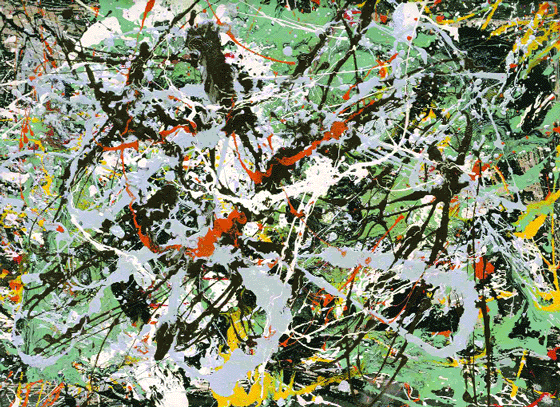By Susan Yung
“No Limits, Just Edges: Jackson Pollock Paintings on Paper”
Through Sept 29, 2006
Solomon R. Guggenheim Museum
1071 Fifth Avenue at 89th Street
(212-423-3500; guggenheim.org)
David Heald, © 2006 Pollock-Krasner Foundation/Artists Rights Society (ARS), New York.
Jackson Pollock’s “Untitled (Green Silver),” 1949: a pulsating tangle of pigment.
In American art, there is no greater mythical figure than Jackson Pollock (1912-1956), whose life encompassed the polar extremes of Western cowboy and rebel New York modernist. Born in Cody, Wyoming, he trained with Thomas Hart Benton, participated in the Federal Art Project under the Work Progress Administration, and developed a completely unique abstract idiom before dying in a car crash at 44 after bouts with alcohol and depression.
Pollock’s progression from WPA muralist to surrealist and finally to abstract expressionist is traced in the Guggenheim’s compact but fascinating show of his works on paper, titled “No Limits, Just Edges.” The development of his famous style parallels a beautiful butterfly’s emergence from a gnarly chrysalis, and the show reveals the artist’s copious and often unsuccessful experiments along the way.
A WPA-style watercolor by Pollock (“Harbor and Lighthouse,” ca. 1934-38) may as well have been by Benton’s hand, so similar are the crayon colors and vibrating, realistic elements. Small sketches of organic shapes follow, such as bare tree limbs. Exercises from around the mid-1940s show a lingering adherence to composing pictures on a horizon, even while attempting to plead the case for non-representation with titles like “Abstract Painting” (1943). The title takes on even more meaning as most of the works shown are untitled, but the artwork appears to feature a misty seascape hovering in a border of squiggles. Other pieces feature a pyramidal pile of jittery limb-like shapes; another, a horde of unidentifiable – and somehow, still standing – human, animal, or plant-like figures.
Pollock’s struggle to free his artworks from the force of gravity is nearly palpable.
In some instances he seemed to be able to untether abstract subjects from the ground, allowing red and yellow shapes to float freely on the paper. Occasionally, there’s an incidental whiff of Picasso, Miro, De Kooning, Rouault. Packed images vibrate off of one another, creating a kind of visual combustion. Pollock’s experimentation with Surrealism may have proved key to vaulting him toward abstract expressionism, letting him torment a figure past recognition.
Works from the late 1940s show major progression toward total abstraction – a hypothetical shedding of the mortal coil. In “Number 12,” clusters of drips relate to form a composition, but the bold, unerring dripped lines are individualistic. “Silver over Black, White, Yellow and Red” is a dense tangle of complex drips that breaks past the paper’s edges. And the paper in “Untitled (Green, Silver)” is completely covered with enamel and aluminum paint, a pulsating tangle of pigment. Each vestige of paint has its own characteristics, particularly in relation to the others. A universe of life teems within, and yet it is brilliantly devoid of human pathos.
Following these ‘classic’ works, Pollock continued to evolve his technique in works dating around 1950-2, breathing more air into compositions and using textured, handmade papers that alone make strong aesthetic statements. The marks tend toward the more decorative and arranged than the explosive and speedy. While they are luminous and warmer in feel, they lack the aggression and desperation — the passion — of his late 1940s works.
Although highly planned (despite the impulsive appearance of some of his paintings), dripping, pouring, and splattering paint created graphic records of the artist’s own actions and reflexes — a felicitous imprint of his gestures and minute movements, distantly related to traditional painting. Yet Pollock seems to have retreated in the 1950s to more carefully planning, and marking, his artworks. While they are less engaging, they also seem more at peace. Who knows where the trajectory of his work would have gone had his life not been cut short.


































